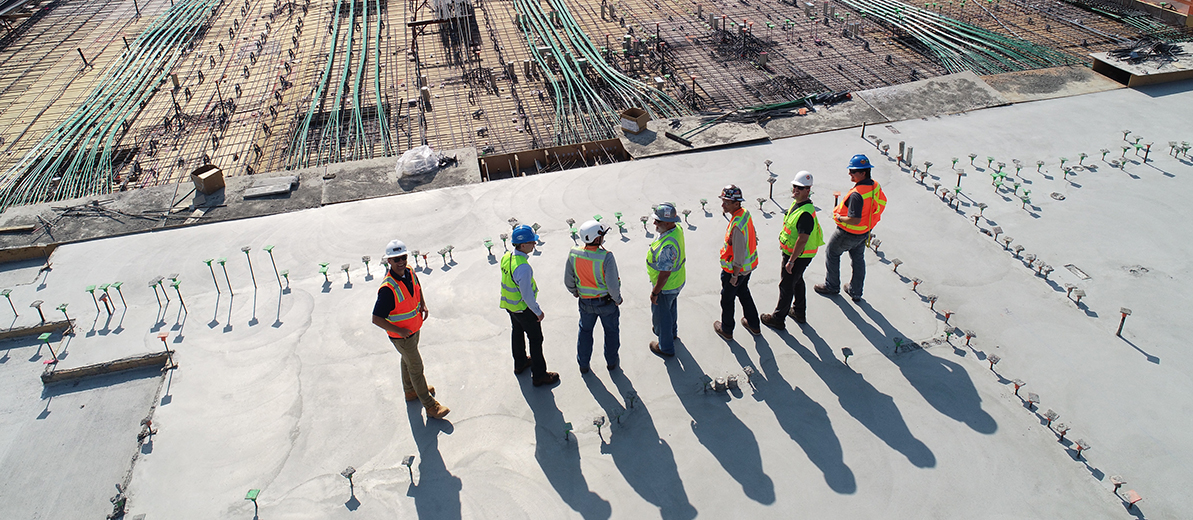
August 25, 2025
Project and Construction Management Terminology
This is the sixth blog post in a six-part series that defines terms commonly used in Engineering, Procurement, and Construction (EPC) project management, construction management, and claims. The first post defined language related to costs, damages, and cost estimating, and the second post addressed construction labor and loss of productivity. The third post covered scheduling and delay, and the fourth post focused on claim types. The fifth post addressed contracts, and this final post covers project and construction management.
Change Control – A documented process applying technical and management review and approval of changes to scope, schedule, and cost baselines.
Change Management – The process of actively managing and addressing changes within a project, ensuring that any modifications to the scope, schedule, cost, or resources are handled effectively while minimizing disruption and maximizing owner and contractor agreement.
Change Order Proposal – The document prepared to provide a complete description of a proposed change and its resulting impacts on project baselines.
Change Order (also see Directed Change) – A formal change to the contract pursuant to the Changes clause in the contract, wherein the scope of work is either increased or decreased, or the required means or method of performance is changed. The Change Order will also identify the increase or decrease in the contractor’s compensation and may also identify any change to the contractual completion date. Also referred to as a “variation.”
Claim – An assertion or request for an adjustment to contract price and/or time for completion by one of the contracting parties seeking adjustment or interpretation of an existing contract subject to the contract Dispute clause.
Configuration Management – Technical and administrative direction and surveillance actions taken to: 1) identify and document the functional and physical characteristics of a configuration item; 2) control changes to those characteristics; and 3) record and report configuration change processing and implementation status.
Constructive Notice – Most construction contracts, whether they are standard or customized forms, contain specific provisions related expressly to the process of giving “notice.” The notice generally refers to an obligation on the part of the contractor to notify the relevant party administering the contract, normally the architect, resident engineer, or owner’s representative, of a claim or change event that gives rise to possible additional entitlement for time and/or cost. The duty imposed upon the issuing party when giving notice in terms of information to be supplied and the time for performance of any specific and designated obligations varies with the form of contract employed.
Deliverables – Those items, contractual or otherwise, requiring delivery to another area of responsibility. Deliverables can be project documents, such as drawings, schedules, procedures, purchase orders, etc.; physical items to be installed in a facility, such as equipment or materials; or components of or the entire completed facility or project.
Design Development – Transitional phase of architect/engineer (A/E) services in which the design moves from the schematic phase to the detailed design phase. In the design development phase, the A/E prepares drawings and other presentation documents to crystallize the design concept and describe it in terms of architectural, electrical, mechanical, and structural systems. The design development phase is a refinement of the Scope of Work identified during conceptual design. As required, large-scale drawings, mock-ups, and detailed plans are developed to present a coordinated, clear view of the project’s major elements with respect to architectural, structural, mechanical, electrical, plumbing, equipment, civil, landscape, and utility infrastructure. In an EPC contract, if a contractor contracts to perform a detailed design from a FEED design (Front End Engineering Design), certain design development must be performed. Certain changes to the FEED design documents would not be considered scope changes and instead design development. For example, detailing out the small-bore pipe with valves, drains, etc. in a piping system from the FEED piping design would be considered design development.
Front End Engineering Design (FEED) – A contract to perform sufficient engineering and preparation of the technical specifications and drawings that describe the project in sufficient detail that a contractor can prepare a bid to perform the detailed design, procurement, and construction of the project. The scope of the FEED typically comprises the following:
- Develop the functional requirements of a facility, typically a process plant or power plant.
- Complete the design basis.
- Develop the detailed scope of work for the bidding contractors for the Engineering, Procurement, and Construction (EPC) phase.
- Define the configuration of the facility and its major systems.
- Develop a design specification for detailed engineering.
- Conduct safety studies and assess risks.
- Define major interfaces.
- Produce drawings (process flow diagrams, Piping and Instrumentation Diagrams (P&IDs), preliminary plot plans, preliminary general arrangement drawings and piping layout drawings, and specifications.
Long-Lead Item – Some component of the project, often a critical piece of equipment or material, that requires a significant amount of time to acquire and thereby represents a potential threat to schedule achievement.
Organization Breakdown Structure (OBS) – The hierarchical system depicting levels of responsibility within a performing organization, in terms of groups, divisions, projects, or responsible teams.
Performance Criteria – The fundamental technical, operating, and design requirements necessary to develop an operation and/or design. These criteria include such items as minimum performance capabilities, reliability, independence, separation, operating costs, and safety. The criteria incorporate operational and regulatory requirements, industry codes and standards, and engineering experience.
Performance Measurement Baseline – The time-phased budget plan against which project performance is measured. It is formed by budgets assigned to scheduled cost accounts.
Performance Measurement Criteria – The performance measurement criteria quantitatively define what products or tasks need to be accomplished to achieve the primary goals of the project and what constitutes satisfactory completion of those tasks.
Project – A unique major effort within a program that has firmly scheduled beginning, intermediate, and ending date milestones; prescribed performance requirements; prescribed costs; and close management, planning, and control. The project is the basic building block in relation to a program that is individually planned, approved, and managed.
Project Control – The planning, scheduling, budgeting, estimating, work authorization, cost accumulation, performance measurement, reporting, change control, documentation, and other systems used to plan and control the work.
Project Control System (PCS) – The planning, scheduling, budgeting, estimating, work authorization, cost accumulation, performance measuring, change control, and documentation system used to plan and control the scope, cost, and schedule for performance of the work.
Project Management Plan (PMP) – A set of documents designed to describe with sufficient detail the policies, standards, strategies, approaches, processes, conditions, parameters, objectives, and deadlines of the project.
Project Manager – An individual in an organization who is responsible for the management of the project. The person held responsible for accomplishing the project scope, schedule, and cost objectives.
Project Office – The organization responsible for overall management of the project. The project office may be system- or product-specific, or may be responsible for many projects in a specific phase of the product.
Quality Assurance – All planned and systematic actions necessary to provide adequate confidence that a facility, structure, system, or component will perform satisfactorily in service.
Quality Control – All actions necessary to control and verify the features and characteristics of a material, process, product, or service to specified requirements. Quality control is the regulatory process through which one measures actual quality performance, compares it with standards, and acts on the difference.
Requests for Information (RFI) – A formal request by the contractor for information or clarification of drawings, specifications, or work scope that may be unclear, ambiguous, or not yet provided to the contractor to perform its work.
Risk – That level of uncertainty at which a decision maker knows, at least, the possible results of an action and can attach subjective probabilities to them.
Scope – In baseline management terminology, the term “scope” refers to those performance and design requirements, criteria, and characteristics derived from project needs that provide the basis for project direction and execution.
Technical/Scope Baseline – A document or a set of documents formally designated and approved at a specific time that define the scope of work to be performed. Technical baselines, plus approved changes to these baselines, constitute the current configuration identification.
Uniform Commercial Code – The Uniform Commercial Code (UCC or the Code), first published in 1952, is one of a number of uniform acts that have been promulgated in conjunction with efforts to harmonize the law of sales and other commercial transactions in all 50 states within the United States of America.
WBS Dictionary – The WBS dictionary lists and defines the specific WBS elements for the WBS and consists of an index and element definitions.
WBS Dictionary Element Definition – The element definition describes the elements contained in the WBS dictionary index.
WBS Dictionary Index – The index lists the preliminary elements extended to the lowest level required. The configuration-controlled documents that clearly define and account for the planning and execution of all work required by the contract.
WBS Elements – The individual products specified in the WBS are termed “WBS elements.” Each element is a discrete portion of the WBS and is composed of either an item of hardware, a service, or data.
WBS Level – The WBS level represents the location of the various WBS elements in the multi-tier framework of the WBS. Descending levels provide increasingly detailed definitions of the end product.
Window – A term used in schedule delay analysis that defines the work performed between two schedule updates.
Work Authorization – A documented process or system that ensures work is properly authorized and assigned at the appropriate organizational levels prior to beginning the work.
Work Breakdown Structure (WBS) – The WBS is a multi-tier framework that organizes and graphically displays elements representing work to be accomplished in logical relationships. The WBS should be organized such that each element can be estimated, scheduled, and budgeted and work progress can be reported.
Work Package – Subdivisions of the lowest-level WBS element accorded detailed scope, schedule (start and finish points), budget, a description of scope (including activities), and responsible manager.
Work Scope – An objective plan that constitutes the work necessary to plan, execute, and control the project that will be approved and meet technical requirements.
ADDITIONAL RESOURCES

Blog
Discover industry insights on construction disputes and claims, project management, risk analysis, and more.
MORE

Articles
Articles by our engineering and construction claims experts cover topics ranging from acceleration to why claims occur.
MORE

Publications
We are committed to sharing industry knowledge through publication of our books and presentations.
MORE
RECOMMENDED READS
Costs, Damages, and Cost Estimating Terminology
This blog post is part of a series defining industry terminology. This post defines language related to costs, damages, and cost estimating.
READ
The Role and Benefit of a Consultant in a Construction Project: Part 1
This is the first blog post in a two-part series on the role and benefit of a construction consultant.
READ
A Tale of Two Claims: Same Contract, Two Fates
The success of a claim often hinges not on what happened in the field, but how it was documented, analyzed, and communicated.
READ

